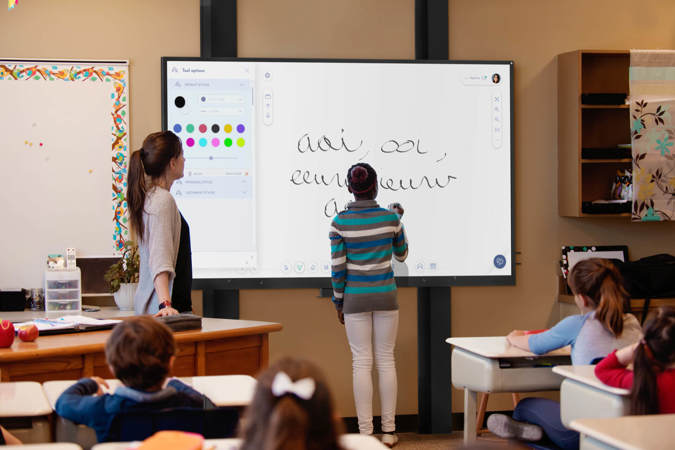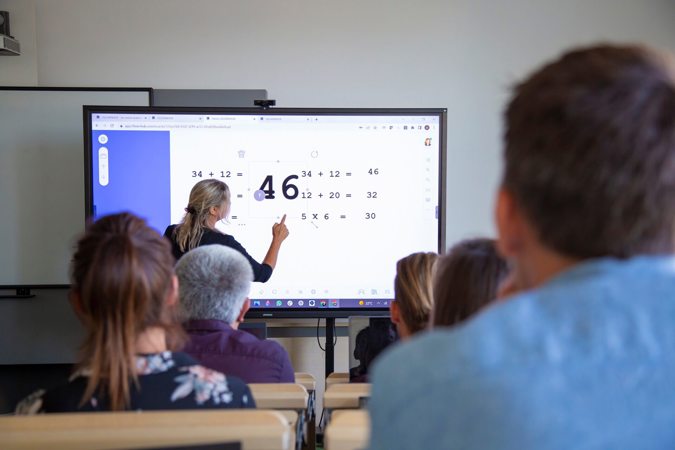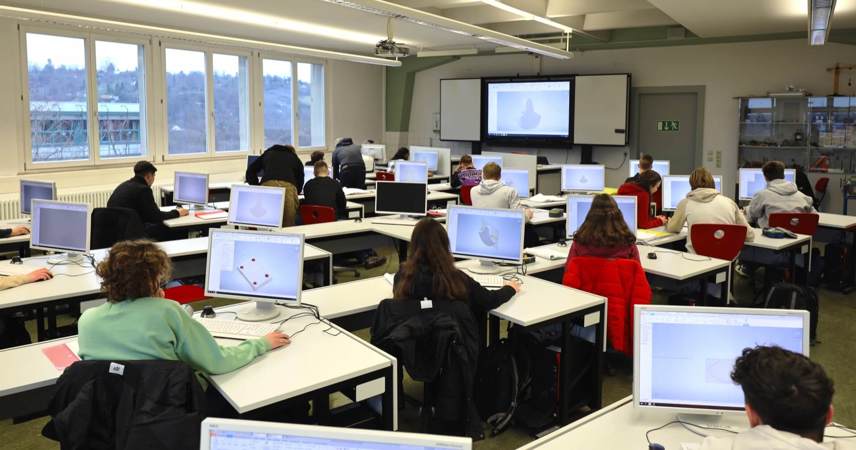5 Proven Ways Interactive Whiteboards Improve Learning Outcomes
In this comprehensive analysis, we explore the tangible benefits an interactive whiteboard brings to the classroom. Research has found that interactive whiteboards contribute to better student achievements, make learning more engaging and cater to diverse learning styles.
Introduction
As we traverse the digital era, the educational landscape has been significantly reshaped, with technology emerging as a crucial component of contemporary learning. One such technology is the interactive whiteboard (IWB), a device that reimagines classroom dynamics and revolutionizes conventional teaching methods. This tool provides educators with a platform to deliver lessons in a manner that is more captivating, interactive, and intuitive. The visual and interactive capabilities of IWBs can make abstract concepts more accessible, accommodate various learning styles, and transform learning into a more engaging process. However, it is important to note that adopting IWBs, despite their numerous benefits, also presents certain challenges. This discussion will delve into how IWBs can improve learning outcomes, the obstacles encountered during their adoption, and practical strategies to mitigate these issues.
1. Student Performance and Achievement
Educators have experienced first-hand the shift in teaching that technology has brought about. Technology, especially tools like interactive whiteboards, has become an integral part of the modern classroom. In this section, we will explore some fascinating research findings that show how interactive screens for schools and online learning strategies can lead to better student achievement.
Imagine transforming your classroom with interactive whiteboards. These high-tech touch screens for schools do more than just display information - they can be a game changer for students' writing skills. Research has shown that when students use interactive screens for education, particularly for group writing projects, they think more deeply about their writing and improve their planning, monitoring, and evaluation skills. The study compared using a modern, interactive whiteboard and a traditional whiteboard and found that students in the interactive whiteboard group performed better.
Moreover, research has found that interactive whiteboards can help foster positive mathematical thinking and engagement in students, encouraging them to dive into mathematical reasoning and problem-solving and join in mathematical discussions in the classroom. As students develop their digital competencies, they can better leverage the capabilities of IWBs to boost their learning outcomes.
Another pedagogical area where interactive touch screens for schools can also significantly boost students' performance is vocabulary learning. Students who used an interactive whiteboard have been found to be more motivated and perform better on vocabulary tests than those who didn't. When it comes to mathematics, IWBs can also play a significant role. A long-term study found a link between students' engagement in IWB activities and their math achievement. These boards allow for real-time feedback, group discussions, personalized learning, and fun game-based learning, stimulating students to engage with the material. Interestingly, the same study found that girls using IWBs for ongoing assessment in math tended to do better than boys over time.
Now, let's think about the 'flipped classroom' approach, where students first learn new material online by themselves, usually at home, and then do their homework in class with teacher guidance. This approach can lead to positive learning outcomes when implemented fully online, especially for students who participate in scheduled (synchronous) and self-paced (asynchronous) learning activities. It turns out that students who watch more pre-recorded lectures tend to be more engaged in live learning sessions and even score higher grades.
There's a lot to unpack here, but it's clear that technology, like IWBs, and online learning strategies, can benefit our students' learning. As we continue to explore these tools and techniques, we might just be shaping the future of education.

2. Student Engagement and Motivation
Active learning strategies, some of which may include interactive whiteboards, can transform the classroom experience, leading to higher student engagement and motivation. Here, we explore how an interactive whiteboard can contribute to a more dynamic learning environment.
Far from mere high-tech chalkboards, IWBs provide students with rich, immersive learning experiences that foster critical thinking and deeper understanding. In a language class, the IWB can enable students to be fully immersed in a different culture, with audiovisual cues and interactive activities that ignite students' imaginations and curiosity.
A wealth of research indicates a generally positive response to IWBs from students and teachers, with evidence pointing to increased student motivation and improved learning outcomes. One of the primary ways IWBs facilitate active learning is through multisensory engagement. As students see, touch, and interact with the material on the screen, their recall improves, and learning becomes more engaging and interactive.
These interactive experiences are especially relevant in today's multimedia-centric world, mirroring the engaging environments students encounter in computer games or on TV. For students with intellectual disabilities, IWBs offer a significant advantage, utilizing visual aids that tap into these students' visual processing strengths.
However, the effectiveness of IWBs is not guaranteed. Their impact depends on teacher training, confidence, school culture, technical support, and the time invested in lesson preparation. It's important to acknowledge these elements to fully leverage the potential of IWBs and create a teaching and learning environment that is truly enhanced by active learning strategies.
3. Collaboration and Group Activities
How can we make classroom learning more interactive and collaborative? Let's explore the power of interactive whiteboards in enhancing collaboration and group activities, especially in the age of online learning.
Interactive whiteboards (IWBs) are more than a teaching tool. They're a platform for collaboration, a shared workspace where students can brainstorm ideas, solve problems, and work together on group activities. This collaboration isn't just for traditional classrooms. It also extends to the online world, especially in flipped classrooms where students take a more active role in their education.
In flipped classrooms, students learn new material online before class, then use class time to dive deeper into the material with their teacher's help. IWBs can enhance this model by making online learning more interactive and engaging. When integrated into live virtual classes, digital whiteboards allow students and teachers to interact and build ideas. This co-construction of ideas can make learning more exciting and dynamic, helping students understand abstract concepts better and increasing their overall engagement.
Research also found that students who are prepared for online classes, showing up on time and keeping their webcams on, tend to interact more with their classmates and teachers. This active participation fosters a collaborative and supportive learning environment, further enhancing learning outcomes in online flipped classrooms.
Beyond the classroom, in the broader landscape of online higher education, IWB technology promotes social engagement among students. Instructors can use digital whiteboards to create interactive learning environments, encouraging students to engage with each other and the course material. This increased social engagement can make online learning feel less isolating, fostering a sense of community and connection among students and teachers.
The future of education is interactive, collaborative, and tech-enabled. Interactive whiteboards, whether in traditional or hybrid classrooms, can be a powerful tool for making learning more engaging and effective. It's not just about learning; it's about building a community, a space where every student feels connected and supported.
4. Teaching Efficiency and Flexibility
The interactive whiteboard isn't just a tool for students; it's also a powerful aid for teachers. Let's look at how IWBs can improve teaching efficiency and offer flexibility in the classroom, enhancing the overall teaching and learning experience.
Teaching English, especially to young learners who may not be highly motivated, can sometimes be challenging. But, with the use of IWBs, teachers can incorporate interactivity into their lessons, making learning more engaging and thus improving teaching effectiveness.
The use of technology has been found to have a positive impact on foreign and second language learning. Techniques like computer-mediated communication, mobile learning, and game-based approaches, all possible with IWBs, can be particularly effective for supporting second language learning. This interactivity can be especially useful in primary schools, sparking curiosity and enthusiasm in young learners.
The IWB also lends a great deal of flexibility to teachers. Preparing lesson materials in advance or making last-minute changes becomes much easier with a digital platform. Teachers can easily pull up past lessons for review or reflection, making teaching more efficient and adaptable.
But there's more to IWBs than just convenience and adaptability. Teachers who use IWBs develop their technological pedagogical content knowledge (TPACK). This is the technical term for teachers' ability to effectively integrate technology into their teaching strategies. As teachers strengthen their TPACK, their performance improves, enhancing students' learning experience.
By improving teaching efficiency, offering flexibility, and enhancing pedagogical strategies, IWBs can be a game-changer in the classroom. So, teachers, as you plan your next lesson, consider the power of the interactive whiteboard at your disposal.

5. Multimedia and Interactivity
What makes an interactive whiteboard so unique? It's not just the "wow" factor of the technology but the multimedia capabilities and interactivity it brings to the classroom. Let's delve into how this can transform learning.
Imagine a classroom where lessons come alive, where visual representations of concepts make learning more intuitive. That's what IWBs can do. Teachers can create interactive lessons that support learning and enhance students' thinking abilities. The visual element of IWBs helps to clarify abstract concepts, providing an engaging and effective learning experience.
But the power of IWBs doesn't stop at visual representations. Its multimedia capabilities can pique students' interest and help bridge the gap from concrete to abstract learning. It caters to diverse learning styles, providing a rich multimedia experience with audio, video, and interactive elements. This makes it an inclusive tool, catering to the unique learning preferences of each student.
The interactive features of IWBs, like pen and touch interactions, offer students more direct access to visualizations and data. Instead of indirect interaction through menus and dialog boxes, students can engage directly with information visualizations such as bar graphs, line graphs, and scatterplots. This kind of hands-on interaction can enhance the learning experience, making abstract concepts more concrete and understandable.
By embracing the multimedia and interactive capabilities of IWBs, we can create a vibrant and inclusive learning environment that caters to different learning styles and makes abstract concepts more accessible. As we continue to explore and understand the potential of IWBs, we're not just keeping up with the times - we're shaping the future of education.

Challenges of interactive whiteboards in the classroom
Interactive whiteboards are a powerful teaching tool, yet like any technology, they come with their challenges. While they can enhance the learning experience, various factors can sometimes impede their practical use. Let's delve into these challenges and understand what they mean for the future of education.
One of the main hurdles we face in using interactive whiteboards effectively in our classrooms is the lack of adequate teacher training. Without the right know-how, even the most confident teachers might feel unsure about using these tools to their full potential. This uncertainty can sadly turn a powerful learning tool like an IWB into another high-tech slide show gadget. Sometimes, sticking to the old ways of teaching can also stop us from fully incorporating IWBs into our lessons. So, as teachers, we need to bridge this gap between what IWBs can offer and how we're currently using them.
Curricular restrictions, technical problems, and lack of access to IWB-based software tools can also constrain the use of IWBs. Add to this the insufficient support from educational policymakers, and it becomes clear how these factors can hamper the implementation of IWBs.
Teachers' technical confidence in using IWBs can significantly influence lesson planning and student engagement. Additionally, a disconnect between teachers' practice and the pedagogical framework of the IWB can lead to ineffective use of the technology.
Other challenges include teachers' lack of knowledge about troubleshooting IWBs, time constraints, lack of computer competency, and insufficient provision of interactive learning materials. A school's lack of a clear vision concerning IWBs, limited technical support, restrictions on internet use, and low learner motivation can further limit the effectiveness of IWBs. Financial constraints can also be a deterrent, as implementing IWBs requires a significant investment, which may not be feasible for all schools.
In addition to these practical challenges, some critics argue that the evidence supporting the benefits of IWBs – improved interactivity, student motivation, and learning – is limited. They believe that the effectiveness of IWBs largely depends on the teacher's experience and ability to leverage the technology.
The journey towards effectively integrating IWBs in our classrooms is not without its roadblocks. However, understanding these challenges is the first step towards overcoming them. As educators, our task is to embrace technology and adapt our practices and policies to ensure optimal use. The key lies in turning these challenges into opportunities for learning and growth. Let's look at how to address these challenges in the following section.
Strategies to address interactive whiteboard challenges
Despite these hurdles, practical strategies exist to address these challenges and make the most of IWBs in the classroom. To begin with, overcoming the lack of training can be addressed by providing regular workshops and hands-on training sessions for teachers. This boosts their confidence and enables them to integrate technology seamlessly into their teaching practices.
As for the issue of traditional teaching techniques, introducing IWBs doesn't mean discarding these methods. Instead, teachers can blend conventional techniques with the interactive features of IWBs, thereby enriching the learning process. Careful lesson design and planning can ensure a smooth blend of these teaching techniques and IWB interactivity.
Navigating curricular restrictions can be achieved by advocating for a flexible curriculum that embraces the use of technology in teaching. Similarly, technical issues and limited access to software tools can be mitigated by equipping schools with sufficient IT support and resources. The teacher's role in orchestrating lessons becomes paramount here, managing various classroom activities and leading classroom discussions.
Educational policymakers play a crucial role in supporting the use of IWBs. By acknowledging the potential of IWBs in enhancing education, they can devise policies that promote their use and provide the necessary resources for schools.
When it comes to the gap between teachers' practice and the pedagogical framework of IWBs, professional development programs can help bridge this gap. These programs can offer strategies for effective lesson planning and enhancing student engagement using IWBs. The masterful integration of digital software such as i3LEARNHUB into the lesson can be a significant advantage.
Technical issues can be daunting, but with proper training and readily available technical support, these can be managed effectively. Schools must ensure teachers are trained to use IWBs and troubleshoot common issues.
Lastly, addressing low learner motivation and internet restrictions requires creating an engaging and safe online learning environment. Schools can do this by promoting interactive educational websites and IWB activities that cater to various learning styles. However, preparation time for IWB lessons should be considered when planning these interactive activities, as it can take longer than planning a traditional lesson.
While there are challenges to using IWBs, these can be effectively addressed with the right strategies and support. By doing so, we can unlock the full potential of IWBs, transforming our classrooms into interactive, engaging, and effective learning spaces.

Conclusion
Interactive whiteboards in classrooms are more than mere tools - they're gateways to dynamic and engaging learning experiences. They open up vast possibilities for students, becoming catalysts for improved performance and active engagement in learning. These innovative tools promote collaboration by serving as hubs for sharing ideas and group work, nurturing a sense of community in the classroom.
For teachers, interactive whiteboards are allies in streamlining educational practices, offering a more flexible and effective way to manage lessons. By integrating multimedia features, they cater to the varied learning preferences of students, transforming abstract concepts into visual, easy-to-grasp experiences.
This article, grounded in peer-reviewed research, has highlighted the positive impacts of interactive whiteboards while addressing the challenges associated with their implementation. This article shows how potential hurdles, such as teacher training and technology integration into traditional teaching methods, are not insurmountable. Recognizing and addressing these challenges pave the way for a more learner-centered, interactive, and collaborative educational environment.
As we navigate the constantly evolving world of technology, embracing interactive whiteboards in our classrooms represents a significant step towards a brighter educational future. The scholarly research presented here underscores the substantial and positive influence interactive whiteboards can exert in educational settings.
Frequently Asked Questions
What makes interactive whiteboards unique in the classroom setting?
Interactive whiteboards are unique because of their multimedia capabilities and interactivity. They transform the learning experience by providing visual representations of abstract concepts, which enhance students' understanding. IWBs cater to different learning styles, with features such as audio, video, and direct interaction through pen and touch, making them inclusive educational tools.
What challenges do teachers face when using interactive whiteboards in the classroom?
Challenges include lack of adequate teacher training, curricular restrictions, technical issues, lack of access to IWB-based software tools, and insufficient support from educational policymakers. Teachers' lack of confidence in using IWBs can also affect their lesson planning and student engagement.
How to overcome implementation issues with interactive whiteboards in the classroom?
Strategies include providing regular training sessions and workshops for teachers, advocating for a flexible curriculum that embraces the use of technology, equipping schools with IT support and resources, and encouraging educational policymakers to support IWB use. Additionally, teachers can be encouraged to blend traditional teaching techniques with IWBs, and professional development programs can be used to bridge the gap between teachers' practice and the pedagogical framework of IWBs.
How do interactive whiteboards contribute to a more engaging learning environment?
IWBs contribute to a more engaging learning environment by making abstract concepts more accessible and interactive. They cater to the varied learning preferences of students and promote collaboration, serving as hubs for sharing ideas and group work. They also encourage active student engagement through their interactive features and multimedia capabilities.
Are interactive whiteboards effective in improving learning outcomes?
Yes, research shows that interactive whiteboards are effective in improving learning outcomes when implemented effectively. These tools enhance the learning process by offering enriched interactivity, supporting diverse learning styles, and contributing to increased student motivation. While the benefits may vary depending on a teacher's ability to leverage this technology, the potential of IWBs is substantial.
References
Alfaki, I. & Khamis, A. (2018). Difficulties facing teachers in using interactive whiteboards in their classes. https://www.semanticscholar.org/paper/Difficulties-Facing-Teachers-in-Using-Interactive-Alfaki-Khamis/d43451cef368a33d00abf2de2a1e8f72b7af95ba
Campbell, M., Detres, M., & Lucio, R. (2019). Can a digital whiteboard foster student engagement? Social Work Education, 38(6), 735–752. https://doi.org/10.1080/02615479.2018.1556631
Chen, I.-H., Gamble, J. H., Lee, Z.-H., & Fu, Q.-L. (2020). Formative assessment with interactive whiteboards: A one-year longitudinal study of primary students' mathematical performance. Computers & Education, 150, 103833. https://doi.org/10.1016/j.compedu.2020.103833
Dashtestani, S. R. (2019). Teaching efl with interactive whiteboards: Do the benefits outweigh the drawbacks? Language Horizons, 3(1). https://doi.org/10.22051/lghor.2019.26689.1139
De Vita, M., Elen, J., & Verschaffel, L. (2019). Interactive whiteboards in mathematics classroom: improving interaction between students and teachers.
DiGregorio, P., & Sobel-Lojeski, K. (2010). The effects of interactive whiteboards (Iwbs) on student performance and learning: A literature review. Journal of Educational Technology Systems, 38(3), 255–312. https://doi.org/10.2190/ET.38.3.b
Kostikova, I. I., Gulich, O. O., Holubnycha, L. O., & Besarab, T. P. (2019). Interactive whiteboard use at English lessons: From university students to young learners. Revista ESPACIOS, 40(12). https://www.revistaespacios.com/a19v40n12/19401210.html
Kühl, T., & Wohninsland, P. (2022). Learning with the interactive whiteboard in the classroom: Its impact on vocabulary acquisition, motivation and the role of foreign language anxiety. Education and Information Technologies, 27(7), 10387–10404. https://doi.org/10.1007/s10639-022-11004-9
Lant, C. L., & Lawson, M. J. (2016). Interactive whiteboard use and student engagement. In J. Orrell & D. D. Curtis (Eds.), Publishing Higher Degree Research (pp. 33–42). SensePublishers. https://doi.org/10.1007/978-94-6300-672-9_4
Lewin, C., Smith, A., Morris, S., & Craig, E. (2019). Using digital technology to improve learning: Evidence review. Education Endowment Foundation. https://eric.ed.gov/?id=ED612157
Lin, L.-C., Hung, I.-C., Kinshuk, & Chen, N.-S. (2019). The impact of student engagement on learning outcomes in a cyber-flipped course. Educational Technology Research and Development, 67(6), 1573–1591. https://doi.org/10.1007/s11423-019-09698-9
Lopez, O., & Krockover, C. (2014). Contextual factors relevant to elementary teachers using interactive whiteboards in mathematics classroom discourse. Journal of Interactive Learning Research, 25(3), 405–426. https://www.learntechlib.org/primary/p/41970/
Reguera, E. A. M., & Lopez, M. (2021). Using a digital whiteboard for student engagement in distance education. Computers & Electrical Engineering, 93, 107268. https://doi.org/10.1016/j.compeleceng.2021.107268
Teng, M. F. (2021). Interactive-whiteboard-technology-supported collaborative writing: Writing achievement, metacognitive activities, and co-regulation patterns. System, 97, 102426. https://doi.org/10.1016/j.system.2020.102426
Tosuntaş, Ş. B., Çubukçu, Z., & Beauchamp, G. (2021). A new model for the factors that affect interactive whiteboard usage of teachers and its effect on performance. Education and Information Technologies, 26(3), 3575–3592. https://doi.org/10.1007/s10639-021-10428-z
Walny, J., Lee, B., Johns, P., Henry Riche, N., & Carpendale, S. (2012). Understanding pen and touch interaction for data exploration on interactive whiteboards. IEEE Transactions on Visualization and Computer Graphics, 18(12), 2779–2788. https://doi.org/10.1109/TVCG.2012.275

